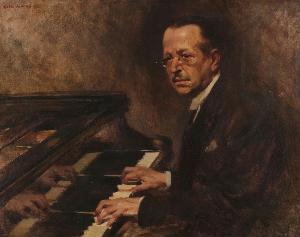Columbano Bordalo Pinheiro
Columbano Bordalo Pinheiro
Style: Impressionism;
Place: Almada
Born: 1857
Death: 1929
Biography:
**CITE**Columbano Bordalo Pinheiro**: The Master of Portuguese Realism Early Life and Training
Columbano Bordalo Pinheiro, a renowned Portuguese Realist painter, was born on November 21, 1857, in Almada, Portugal. He was the son of Manuel Maria Bordalo Pinheiro, a romantic painter, and younger brother of Rafael Bordalo Pinheiro, a great caricaturist. Columbano's artistic journey began under the guidance of his father, Miguel Ângelo Lupi, and sculptor Simões de Almeida. Artistic Career
In 1881, Columbano Bordalo Pinheiro received a scholarship from the Countess of Edla to study in France, where he was influenced by French naturalist, realist, and impressionist painters like Courbet, Manet, and Degas. This exposure broadened his artistic horizons without diminishing his distinctive style, often characterized as gloomy and intimist. - Co-founder of the 'Grupo do Leão', a gathering of artists, writers, and intellectuals in Lisbon's downtown restaurant 'Leão de Ouro' (The Golden Lion), where aesthetic issues were discussed, and Naturalism was proclaimed against academic art.
- Painted portraits of prominent Portuguese society and culture figures, such as José Maria de Eça de Queiroz, Teófilo Braga, Raul Brandão, showcasing his psychological accuracy in defining the personalities depicted.
- His most famous portrait was that of poet Antero de Quental in 1889, which seemed to anticipate Antero's suicide.
Later Life and Legacy As a well-known Republican, Columbano Bordalo Pinheiro was invited to design the flag for the new regime after the Republic proclamation in 1910. He was also nominated as director of the National Museum of Contemporary Art (now the Chiado Museum) in Lisbon from 1914 to 1927. - View Columbano Bordalo Pinheiro's artworks on Wikioo.org
- Read more about Columbano Bordalo Pinheiro on Wikipedia
- Explore the Chiado Museum, where a significant collection of his paintings is housed, on The Museum Praça do Comércio (Lisbon, Portugal)
Key Works and Collections
* Portrait of Cunha Vasco, housed in the Casa-Museu Dr. Anastácio Gonçalves (Lisbon, Portugal), showcases his mastery of portraiture. * José Viana da Mota (1868-1948), a portrait of the Portuguese pianist and composer, is another notable work, demonstrating his ability to capture the essence of his subjects. Influences:
French naturalism, realism, and impressionism; influenced by Courbet, Manet, and Degas. Notable Works:
Portrait of Antero de Quental (1889), Portrait of Cunha Vasco Museums Featuring His Work:
Chiado Museum, Casa-Museu Dr. Anastácio Gonçalves (Lisbon, Portugal), and others. Legacy:
Considered the greatest Portuguese painter of the 19th century, compared to Wilhelm Leibl and John Singer Sargent.
- View Columbano Bordalo Pinheiro's artworks on Wikioo.org
- Read more about Columbano Bordalo Pinheiro on Wikipedia
- Explore the Chiado Museum, where a significant collection of his paintings is housed, on The Museum Praça do Comércio (Lisbon, Portugal)














